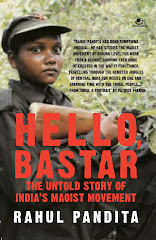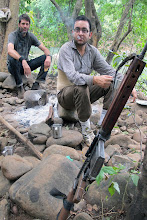
As the line between euphoria and arrogance fades in Sri Lanka, there are indications of tough times ahead for the Tamils
Sri Lanka is like Kosovo of February 2008. And Colombo like Pristina. It is as if the nation has just achieved independence. Prabhakaran is dead for weeks now. But the jubilation is far from over in Sri Lanka.
The streets in Colombo are lined with Lankan national flags. They are everywhere. On top of balustrades. Outside booze shops. Over security barricades. Inside broiler chicken shops. “When I saw all the flags and people, my first reaction was: Sri Lanka must have won a Cricket world cup or something,” said a western tourist.
And then there are hundreds of leviathan billboards, featuring the ‘three musketeers’ – President Mahinda Rajapaksa and his two brothers. The most popular of them is of the President hugging his brother, the defence secretary, Gotabhaya Rajpaksa, and for a moment you would think that he will cry any time, overcome with emotion. Every vehicle has a picture of the President, and, of course, the flag. An autorickshaw driver who didn’t have one said a soldier had stopped him the other day, admonishing him for not being patriotic.
In the morning when the Sri Lankans go to work, they all sing the national anthem. In the evening, they do it again, also observing a two-minute silence for the martyred soldiers. Near the foreign ministry in Colombo, the entire staff of a software company is out, holding Sri Lanka’s national flower, the blue water lily, in their hands. “Sri Lanka is freedom,” said a man among them, struggling with his English.
There is palpable relief on the roads. In a city where life is governed by checkpoints and barricades, the prospect of their disappearance seems unreal. The Sri Lankans, particularly its government servants are basking in the glory of post-LTTE attention they are receiving. A publicity officer, who looks after the accreditation issues of foreign journalists, holds a magazine in his hands, and marks some lines of a report on the Lankan crisis. “This line shows how immature reporters are when it comes to our country,” he remarks with a look on his face which could pass off as glee.
The press accreditation card meant for foreign journalists looks like the most important document in Sri Lanka. As a friend working for a French newspaper quipped, “You cannot even piss without that card in your pocket.” The card enables you to roam around Colombo, take pictures if you like, park your vehicle at hotels in the high-security zone. But that is it. The card is of no use when you want to go to the north. That is where the IDP camps are, home to almost 3 lakh Tamil refugees. North is where the Tamils – even those who are not in camps – have been held up in an area 180 kilometres long, from south to north. They cannot come out. Nobody, particularly a Tamil, cannot go in. Repeated requests for access to one of the IDP camps is met with a poker-faced No.
The last hope for those who are denied access is the Media Centre for National Security, set up in a portion of the Colombo swimming club. Like any other colonial-era building, its wooden stairs creak every time somebody climbs up or down. These days they have been creaking too much. A horde of officers are monitoring television channels all across world, and, after every minute or so, they rush upstairs to the director’s office to update him.
Laxman Hullugalle sits in his office, his chair facing a huge Lankan map. The northern areas are pinned by miniature national flags. Some sections of western media had recently been given access to one of the IDP sites. The reports are damning. “The President has asked us to immediately halt permission to journalists. He has been particularly angry about the BBC report,” he says. “We are not from the BBC,” I tell him. “But that BBC reporter was an Indian,” he replies.
We travel to Vavuniya in northern Sri Lanka anyway without the security clearance. This government has been threatening to prosecute journalists who attempt visiting the northern areas. The Army chief said all foreign journalists are working “against his homeland”. A stringer for Reuters news agency was arrested from one of the refugee camps, and his camera confiscated. Another was brutally beaten up, and his beard and hair shorn.
Even aid agency workers are frustrated. Sarasi Wijeratne, an official with the Red Cross said the clear procedures of access were still lacking. Doctors without Borders says that at the Vavuniya hospital, nearly 2,000 patients are packed into a space meant for not more than 400. UK’s Christian Aid has forewarned that the camps are an epidemic waiting to happen. The agency’s Sajid Mohammed, who visited some of the camps said that there are 30 people living in a tent meant for five. “Some of them looked like as if they had not eaten for days,” he said. There are concerns about children, with a survey revelaing that 25 percent of children in some camps suffered from global acute malnutrition. Aid agencies fear the number could be significantly higher now. The camps are believed to be infested with intelligence sleuths who keep an eye on information leaking out.
We managed to speak to some Tamil families near Vavuniya. The meeting was secretly arranged amidst fear of government spies keeping a watch over Tamil-inhabited areas. One Tamil woman said that they were living in difficult conditions since the Sinhalese neighbours looked at them with suspicion. Breaking into tears, another woman said that some of her relatives were living in one of the IDP camps and she had not heard from them.
Getting into Trincomalee, one of the former LTTE bastions in the eastern region is extremely difficult. The media is discouraged from going there. “We don’t allow western journalists at all,” said an army officer at one of the check points.As one enters the main town, the ravages of the war are distinct. Skeletons of buildings riddled with bullets stand as stark reminder of the last days of the battle.
61-year-old Maruthamuthu Sinniah has come back from India after 24 years. He had left with his family in 1985 when the war between LTTE and the Lankan forces was raging on. One night, eighteen of his relatives were killed by unidentified men. Now, he has returned with his wife to a land where his house stood, razed by the Lankan army after they left. They live under a tattered United Nations tarpaulin. Another Tamil man who also returned from India said that he could notice a number of Sinhalese families who did not live there before.
In fact, one major fear is that the government will bring about a massive change in demographics of the Tamil-majority areas, particularly in the north, by providing incentives to Sinhalese. There are fears of settlements on the Israeli model. The army has already declared that it plans to increase its 2 lakh strong force by about 50 percent. “This helps prop up domestic consumption, and it provides a huge force to control the north, and to help impose the government’s political and development plans in the north,” says Alan Keenan of the International Crisis Group.
In Trincomalee, a Tamil man spoke to us about living there. His business (he wished it not to be identified) was gutted down in the riots against Tamils engineered in 1983 by the Sri Lankan navy. “You don’t know what kind of discrimination we are facing,” he said. “Please don’t quote me, they might just kill me,” he said.
Some Tamil families in Trincomalee were bashed up and some even forced to contribute money for a celebration feast. Fingers have been pointed at a new road being built from a Sinhalese village to a Tamil village, with a number of Sinhalese families being settled on both sides of it.
In the Trincomalee town, right in front of a cinema hall owned by a Tamil, the government has all of a sudden declared four ancient banyan trees as protected monument site. The cinema hall owner was scared of speaking to us, but another Tamil man said that the notice board was just a ploy to usurp the cinema hall.
“They will take away everything,” he said. The cinema man wept behind him.
(This report first appeared in the June 19 issue of the OPEN magazine - page 26 and 27.)





3 comments:
Great stuff. So great that you can tell something of the real story in Sri Lanka (which I know from first hand experience is very difficult to tell if you are in Sri Lanka and want to stay alive). Thank god the Tigers are gone -- but only god knows what horrors Tamils (esp. in Trinco) will suffer from the Sinhalese militants now in power -- who have learned so much from the Tigers. I hope you can get back into Sri Lanka and tell some more stories.
sir..aapka koi jawab nahi...arvind sharma http://www.patronavis.blogspot.com/
Quite worthwhile information, thanks so much for the post.
Post a Comment